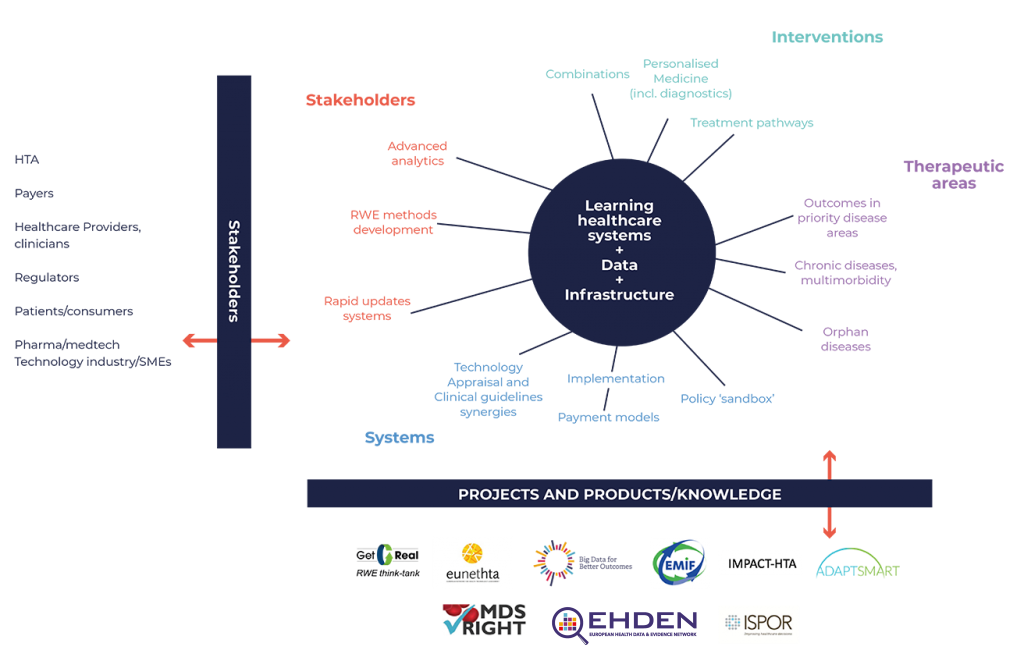
About HTx project
Goals
HTx is a Horizon 2020 project supported by the European Union, kicking-off in January 2019 and lasting for 5 years. The main aim of HTx is to create a framework for the Next Generation Health Technology Assessment (HTA) to support patient-centered, societally oriented, real-time decision-making on access to and reimbursement for health technologies throughout Europe.
Objectives
- HTx will facilitate the development of methodologies to deliver more customized information on the effectiveness and cost-effectiveness of complex and personalised combinations of health technologies.
- HTx will also provide methods to support personalised treatment advice that will be shared with patients and their physicians.
- Finally, HTx will in close collaboration with the European Network for HTA (EUnetHTA) and its stakeholders pilot the implementation of these methods in Europe.
HTx is a Horizon 2020 project supported by the European Union, kicking-off in January 2019 and lasting for 5 years. The main aim of HTx is to create a framework for the Next Generation Health Technology Assessment (HTA) to support patient-centered, societally oriented, real-time decision-making on access to and reimbursement for health technologies throughout Europe.
Objectives
- HTx will facilitate the development of methodologies to deliver more customized information on the effectiveness and cost-effectiveness of complex and personalised combinations of health technologies.
- HTx will also provide methods to support personalised treatment advice that will be shared with patients and their physicians.
- Finally, HTx will in close collaboration with the European Network for HTA (EUnetHTA) and its stakeholders pilot the implementation of these methods in Europe.
Outline of the concept of HTx
Concept
Outline of the concept of HTx

Work packages
Work packages

WP 1 – Lead: University of Utrecht
Treatment pathways in specific therapeutic areas
The specific objectives of this work package are:
- To assess average and individualised real-world effectiveness and cost-effectiveness of health technologies and combinations in the case studies.
- To determine average and individualised real-world effectiveness and cost-effectiveness of treatment pathways in the case studies
- To predict real-world impact of treatment decisions in the case studies
- To explore generalisability of the results of the case studies to other settings and jurisdictions.

WP1 – Lead: University of Utrecht
Treatment pathways in specific
therapeutic areas
The specific objectives of this work package are:
- To assess average and individualised real-world effectiveness and cost-effectiveness of health technologies and combinations in the case studies.
- To determine average and individualised real-world effectiveness and cost-effectiveness of treatment pathways in the case studies
- To predict real-world impact of treatment decisions in the case studies
- To explore generalisability of the results of the case studies to other settings and jurisdictions.

WP2 – Lead: University of York
Using real world data (RWD) for evidence synthesis
The objectives of this work package are to enrich the methodological arsenal related to the use of RWD in order
- To facilitate the HTA of different treatment modalities including health technology combinations and treatment pathways
- To take into account personalised treatment choices
- To make real-world predictions of health outcomes at the population and individual level.

WP2 – Lead: University of York
Using real world data (RWD) for evidence synthesis
The objectives of this work package are to enrich the methodological arsenal related to the use of RWD in order
- To facilitate the HTA of different treatment modalities including health technology combinations and treatment pathways
- To take into account personalised treatment choices
- To make real-world predictions of health outcomes at the population and individual level.

WP3 – Lead: University of Oulo
Using artificial intelligence (AI) to forecast individualised treatments
The overall objective of WP3 is to support the further development of artificial intelligence (AI)/machine learning (ML) systems that can analyse data from different sources in order to predict individual patient treatment outcomes.

WP3 – Lead: University of Oulu
Using artificial intelligence (AI) to forecast individualised treatments
The overall objective of WP3 is to support the further development of artificial intelligence (AI)/machine learning (ML) systems that can analyse data from different sources in order to predict individual patient treatment outcomes.

WP4 – Lead: National Health Care Institute, the Netherlands (ZIN)
Implementation into systems and processes
The specific objectives of this work package are:
- International consensus building on the HTx methods. That will include building consent between HTA organisations in Europe and between HTA organisations, regulators and guideline developing organisations.
- To increase patient-centricity in decision-making.
- To support development of flexible funding and reimbursement models for complex health technologies. This also includes assessment of the transferability of these models throughout Europe

WP4 – Lead: National Health Care Institute, the Netherlands (ZIN)
Implementation into systems and processes
The specific objectives of this work package are:
- International consensus building on the HTx methods. That will include building consent between HTA organisations in Europe and between HTA organisations, regulators and guideline developing organisations.
- To increase patient-centricity in decision-making.
- To support development of flexible funding and reimbursement models for complex health technologies. This also includes assessment of the transferability of these models throughout Europe

WP5 – Lead: Syreon Research Institute
Transferability and dissemination
The specific objectives of this work package are:
- To evaluate and support the transferability of knowledge and methods gained from case studies and analyses to Central and Eastern European countries;
- To develop and implement an extensive and targeted dissemination plan;
- To empower and engage patient representatives in HTX implementation.

WP5 – Lead: Syreon Research Institute
Transferability and dissemination
The specific objectives of this work package are:
- To evaluate and support the transferability of knowledge and methods gained from case studies and analyses to Central and Eastern European countries;
- To develop and implement an extensive and targeted dissemination plan;
- To empower and engage patient representatives in HTX implementation.

WP6 – Lead: Synapse Research Management
Scientific coordination and project management
The specific objectives of this work package are:
- To ensure the project management and scientific coordination of the overall project.
- To act as the primary contact to the commission with respect to legal, financial and administrative tasks

WP6 – Lead: Synapse Research Management
Scientific coordination and project management
The specific objectives of this work package are:
- To ensure the project management and scientific coordination of the overall project.
- To act as the primary contact to the commission with respect to legal, financial and administrative tasks
HTx project structure
Concept
HTx project structure

